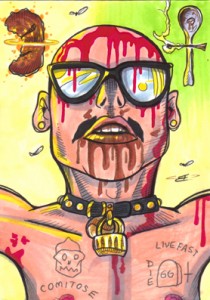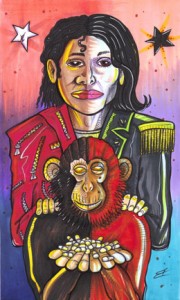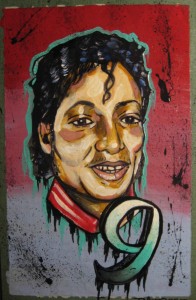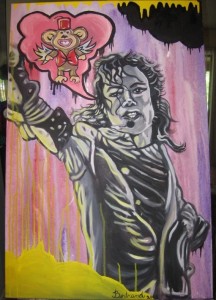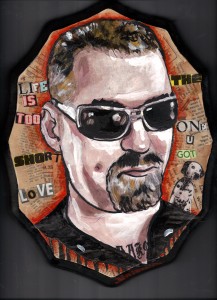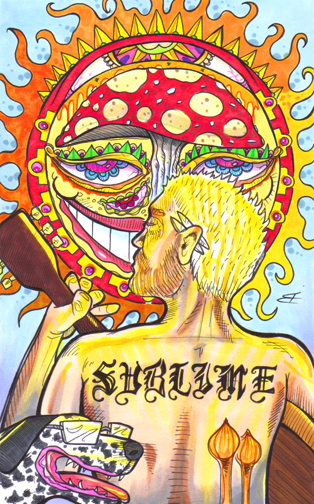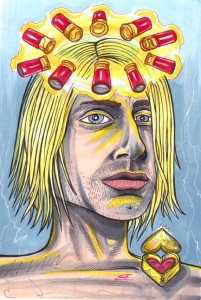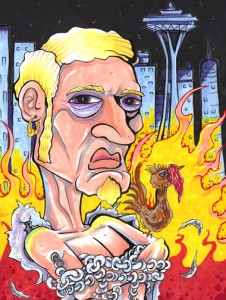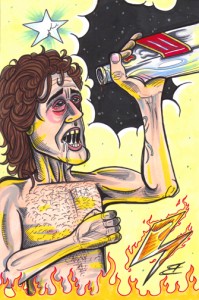“There is only One True God,”
GG Allin told a cringing talk show audience, “and that lives within me—I am that God.” Five days later, on June 28, 1993, he was dead.
Covered in jagged scars and needle tracks, smeared with puke and his own shit, GG Allin proclaimed himself to be the King of the Underground, the Savior of Rock n’ Roll, beyond Good and Evil.
“I believe I am the highest power, absolutely. I am in control at all times. Jesus Christ, God, and Satan all in one.”
The craziest part is that multitudes of kids followed him faithfully. At his peak, the self-described scumfuc rocker bragged that his fanbase was a million strong. Jaded, alienated youth at its finest, throw away kids living out gutter punk fantasies, drunks and junkies, the maladjusted and the mentally deranged, the abused, the morbid, the lost, a sub-society of the anti-social—they needed a hero so badly, some let their superstar pee on their faces.
“I created myself inside the womb from the fires of Hell.”
According to his brother Merle, GG’s rural, religious fanatic father originally dubbed his son Jesus Christ Allin. The Allin boys were New Hampshire hicks, born and raised. Their father was an abusive recluse, at one point digging graves for his family in the cellar and threatening to fill them in the near future. Like many a hayseed in the late 70s, GG packed his bags and headed for the city in search of rock n’ roll, but he always appreciated his up-bringing. “That made me sort of a warrior soul at an early age.” By the mid-80s, he was an underground sensation.
On the surface, GG Allin appears to be a brain-damaged retard, but there is a cleverness to his songs that can’t be denied. Not surprisingly, the singer could hardly keep a backing band for more than a year. Only his brother Merle, who played bass, stood beside him to the end.
GG played at various times with the Jabbers, the Scumfucs, the Holy Men, the Texas Nazis, the AIDS Brigade, and a number of others before assembling his final band, the Murder Junkies. Nearly all of his songs were primitive punk rock, though he did a number of country tunes in the vein of the only hero he ever claimed, Hank Williams. A perusal of his song-titles shows the direction of his message:
- “Bored to Death”
- “Drink, Fight, Fuck”
- “Anti-social Masturbator”
- “Expose Yourself to Kids”
- “Young Little Meat”
- “Last in Line for the Gangbang”
- “You’ll Never Tame Me”
- “Castration Crucifixion”
- “Suck My Ass It Smells”
- “War in My Head – I Am Your Enemy”
- “Die When You Die”
- “Violence Now – Assassinate the President”
- “Kill the Police – Destroy the System”
- “I Am The Highest Power”
- “No Room for Nigger”
- “I Live to be Hated”
- “Kiss Me in the Gutter”
- “Immortal Pieces of Me”
- “When I Die”
GG Allin’s albums spread through the punk scene like hepatitis germs on Sid Vicious’ syringe, but his true claim to fame was his ultra-violent stage show. “If you come to my show, you’re going to a war,” he proclaimed. “My mind’s the machine gun, my body’s the bullets, and the audience is the target.”
Going to a GG Allin show was like swimming in a sewer full of drunk Irishmen—you came out battered and smelling like shit. The singer usually took the stage in nothing but a studded dog collar. His shaved head, hairless torso, toothless maw, and thimble-sized penis gave him the appearance of an overgrown infant covered in jailhouse tattoos and throwing a temper tantrum.
“My rock n’ roll is not to entertain, but to annihilate. I’m trying to bring danger back into rock n’ roll, and there are no limits, and no laws, and I’ll break down every barrier put in front of me until the day I die.”
GG smashed bottles and sliced into his flesh like old newspaper. He would typically ingest laxatives and empty his bowels on stage, eating his own turds like a household dog before smearing the bacteria-infested feces into his self-inflicted wounds, which frequently put him in the hospital.
Geared up on dope and ear-shredding guitar chords, he tore into the audience throwing kicks and punches—along with handfuls of poo with all the fury of a pissed chimpanzee. GG even claimed to have raped both women and men on stage, although there were plenty of damaged goods in the audience who were more than willing to service their Savior. He liked to brag about defiling girls barely in their teens.
“My body is the rock n’ roll temple,” he told Geraldo’s jeering audience, “and my flesh, blood, and body fluids are a Communion to the people—whether they like it or not.”
Some fans cheered, some puked, and more than a few beat the living damnit out of Allin. At one Texas show, fifteen kids fed him the boots at once, breaking his arm. Love him or hate him, such vile intensity has never been seen before or since.
“It’s not a performance, it’s a ritual.”
GG’s antics, on stage and off, got him arrested over fifty-two times in twelve states. “I’ve been to jail many, many times…and every time they put me in jail…I come out that much stronger.” In 1989 he did a year and a half in Jackson State Prison (MI) for assaulting—and allegedly raping—a female fan. He told Jerry Springer’s talk show audience:
“Okay, I cut her, I burned her, I drank her blood, but she also did the same to me! It was a consensual agreement, but in the courtroom they said I was to blame because I’m GG Allin. I’m the King of the Underground—they need to nail me to a cross.”
For all of his insistence that whiners should overcome their weaknesses instead of playing the victim, GG certainly groaned under the unfairness of his own cross like a true martyr. Much of his allure revolved around his repeated promises to kill himself onstage. Year after year, he assured fans that on Halloween he would off himself and take as many people in the crowd as he could with him.
“I will commit suicide on stage and the blood of Rock N’ Roll will become the poison of the Universe forever.”
There is an astonishing degree of mysticism to GG Allin’s performance art. His unconcealed indulgence of primal desires was juxtaposed with material simplicity that only a monk could appreciate. Most rock stars make a pact with the Devil so they can enjoy lavish lifestyles and physical perfection. Not GG.
“Pretty much everything I own [will fit] in a paper bag. To me, it seems like it’s the only way to live… So possessions don’t mean anything to me. I don’t need anything, so that way they can never catch me.”
Allin was profoundly self-absorbed, and yet his self-mutilation and disregard for things of this world are reminiscent of the fleshly mortification and renunciation common to the most stringent yogis of India, the shamans of tribal societies, or the Gnostics of the ancient Mediterranean.
“It’s like my soul is just, it’s just beyond this fucking Universe… It can’t be confined. It’s like I’ve got this wild soul, it wants to get out of this life. It’s too confined in this life, and I think, to take yourself out at your peak, if you can die at your peak, your strongest point, your soul will be that much stronger in the next existence.”
GG Allin’s turd-hurling rampage across America was conceived as an infernal ceremony.
“I believe you can make forces of good and evil work for you, to get what you want. I’ve done black masses that worked for me.”
Upon being released from Jackson Prison in 1991, he began to gather his emotionally crippled fans around him for the complete destruction of society as we know it, hastening the arrival of what Aleister Crowley would call the Age of the Crowned and Conquering Child. Talk show producers and club owners lined up to provide a soapbox for GG’s psychotic Christ complex.
“I have so much hatred because I look at these people, these robots, these conformists, these people that dress in these uniforms, and I’m sick and tired of it,” he told Jane Whitney’s disapproving audience.
“I am the Messiah, I rule the rock n’ roll underground. I’m bringing us to a revolution against the government, against the police, against any form of society that is trying to put us down and restrict us in any way, shape, or manner.”
The scumfuc kids went apeshit for his delusional rants.
In June of 1993, GG Allin went to see the culmination of his career in film, Todd Phillips’ Hated: GG Allin and the Murder Junkies. Fired up on his own image, the 36 year-old singer appeared on The Jane Whitney Show with two 17 year-old girls who referred to him as “God.”
“I will die for him,” Wendy said to the consternation of a finger-wagging public. “He is my God, he is my daddy… On Father’s Day, my daddy gave me the great gift of letting me watch him masturbate and I got to piss in his mouth and it was the greatest father/daughter experience I’ve ever had in my life.”
All across America, hand-wringing housewives in the grip of the Satanic Panic prepared for the worst. Is this what children have become? Surely the world must be coming to an end.
On June 27, GG played a brief show at The Gas Station in Manhattan’s Lower East Side, after which he roamed the streets covered in blood with a gaggle of grubby fans trailing behind him. The only things missing were a donkey and some palm fronds. GG wound up at an apartment nearby, where he snonked a fat bag of heroin. His friends thought it would be funny to take pictures of themselves next to his unconscious body. The next morning, they realized he was dead.
The postmortem photo ops didn’t stop there, though. A few days later, GG Allin laid in his casket wearing nothing but his leather jacket and a jock strap that read “EAT ME”, which attendees pulled down to playfully diddle his wingy. They placed a microphone in one hand and a bottle of Jim Beam in the other, then crammed his mouth full of pills and tapped cigarette ashes on his discolored face as they remembered his life.
Sure, GG’s death was pretty anticlimactic for those who envisioned him cramming a stick of dynamite up his ass and blowing half the audience to smithereens, but they made the best of it.
GG Allin’s artistic career is viewed by some as the equivalent of a chronic sex offender who carries a video camera into a nursery, while others paint a more grandiose, metaphorical picture of American society eaten alive with sexual deviance and an unquenchable thirst for violence.
As I write this from a ghetto motel, listening to the sounds of tireless domestic violence above me, I am inclined to agree with the latter interpretation. GG’s work may have been decadent and disgusting, and I would undoubtedly shoot his ass and bury him in the woods if he ever moved into my neighborhood, but perhaps the artist should have the last word on his own demented legacy:
“Strip away all the shit from rock n’ roll and what you got left is me.”
© 2011 Joseph Allen
GG Allin and the Murder Junkies — “Bite It You Scum”
1993
